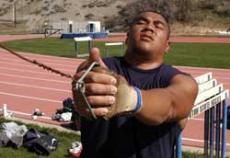Here’s How: Step-by-step sports; Getting Hammered
Popularized by Ms. Trunchbull in Rhold Dahl’s book “Matilda,” the hammer throw is a sport that requires precision and technique.
Matt Ingebritsen, throw coach for the Utah State University field team, said the hammer throw is a sport that originated in Europe and has been played by anybody from peasants to kings.
He said while the hammer throw wasn’t part of the original Olympics – javelin and discus being the two throwing events – the hammer throw has been included in the Olympics since it was reinstated.
The hammer looks much like a ball-and-chain ankle cuff common to prisoners in ancient times.
The hammer has a handle wide enough for two hands to grasp. A strong wire runs from the handle to a 16-pound spherical weight.
The purpose of the hammer throw, much like any throwing sport, is to throw the hammer as far as possible.
Since the hammer throw involves careful technique, there are multiple steps involved to throw the hammer in the right direction and give it distance.
How the hammer is held is dependent on the hand preference of the thrower. A right-handed person will hold the hammer with the left hand and spin in a counter-clockwise direction.
A left-handed person will hold the hammer with the right hand and spin in a clockwise direction. The thrower usually wears a leather glove on the throwing hand.
The hammer throw takes place inside a cage much like a the backdrop in baseball. Inside the cage is a cement pad with a circle. The thrower performs all their movement within in this circle.
Kevin Liu, a hammer thrower for the USU track and field team demonstrated the steps to throwing the hammer.
He said the first step to throwing the hammer is to stand in the circle facing the opposite direction of where the thrower wants to throw the hammer. He said the thrower holds the hammer in their throwing hand, raises it and spins the hammer over their head a few times to develop a rhythm for the throw.
Next, the thrower bends their legs slightly to get their mass closer to the ground to counter the effects of the spinning hammer, Liu said.
The throw brings their arms down to chest level with arms extended, still holding onto the hammer, he said. Pivoting on the the feet, the thrower turns the hammer and their body 180 degrees and steps through with the right leg to catch the hammer for the next turn, he said.
The thrower is now facing the direction the hammer will be thrown.
The thrower repeats this 180 degree turn and again places the right foot over the left leg to counteract the gaining momentum of the ball, he said.
This 360 degree rotation continues three or four times to allow the hammer to increase momentum, which allows it to be thrown farther, he said.
Liu said to release the hammer, the thrower faces the direction they want the hammer to go and on their last rotation, let go of the handle, releasing it at a 40 degree angle.
He said the thrower follows through by throwing their hands straight in the air.
“Then if you know it’s a good throw, you give a big scream and yell ’til the ball hits the landing area,” Liu said. “Then you walk out the back of the ring under control.”
-sethhawkins@cc.usu.edu

(Timothy Mecham)

(Timothy Mecham)

(Timothy Mecham)

(Timothy Mecham)

Utah State’s Kevin Liu holds up a track-and-field hammer. Similar to a ball-and-chain, it is a 16 pound ball attached to a four-foot wire. (Timothy Mecham)

